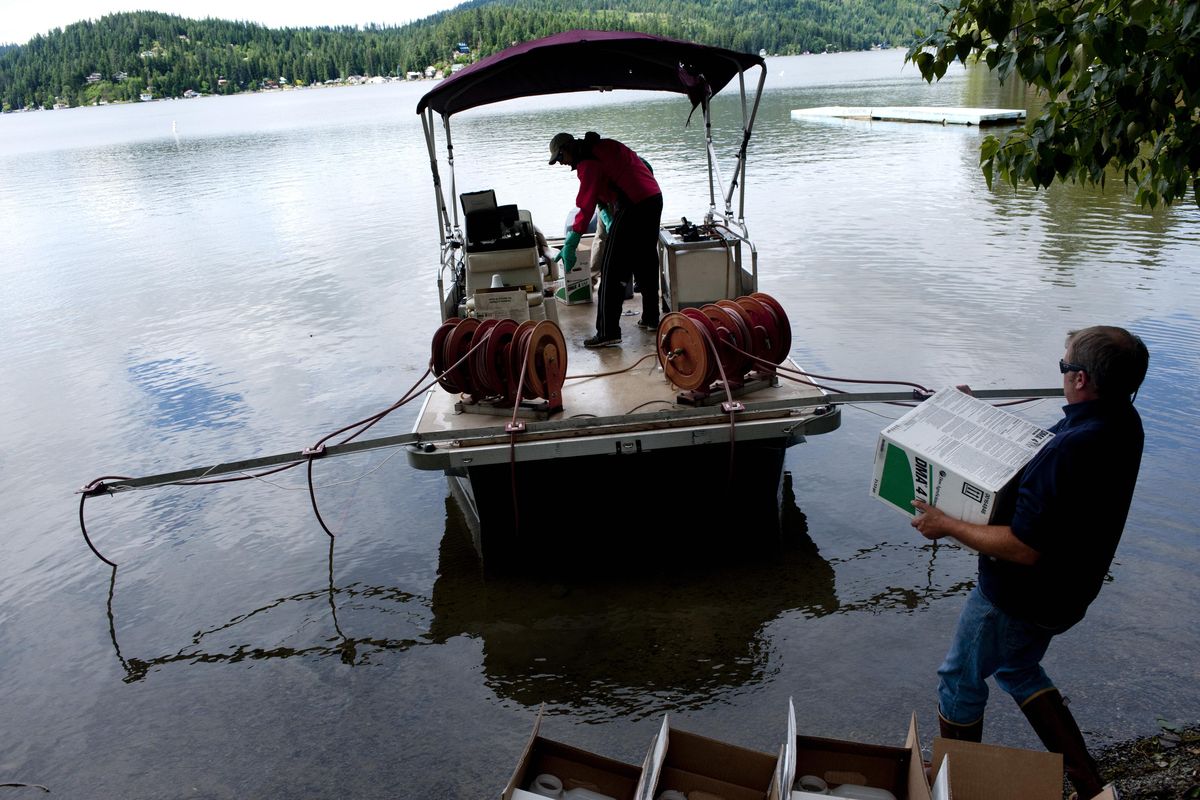Milfoil battle goes lakewide
Big patches of Newman Lake being hit with chemical 2,4-D

An aluminum boat with orange hoses hanging off the stern slowly plied the waters of Newman Lake on Tuesday morning spreading liquid herbicide over invasive Eurasian milfoil.
Ninety-one acres of the lake are being treated this year in an effort to eliminate thick mats of the aquatic weed that spreads easily once it gets a foothold in a waterway.
The treatments will continue next year in an aggressive effort to reduce Newman Lake’s 11-year-old infestation.
Boaters and swimmers were asked to stay off the lake for a few days this week to prevent disturbances that would reduce the herbicide’s effectiveness.
Only one recreational boat was seen during the morning applications, so it appeared that boaters were complying with the voluntary request.
“The weather is kind of yucky anyway,” said Susan Schuler of the Newman Lake Resort, where activity was subdued for a summer day.
She said her business might suffer as people stay off the water, but it should bounce right back with hot weather expected this weekend.
“Our goal is what’s best for the lake overall,” she said.
Eurasian milfoil in Newman Lake has been treated with herbicides regularly, but some of the milfoil has been growing in deeper water and can’t be seen from the surface.
Soundings were taken by Washington State University scientists last year and earlier this year to identify deeper beds that appear to be contributing to the worsening problem, said Karen Kruger, water resources technician for Spokane County.
Herbicide applications were limited during the past two years, which allowed milfoil to begin to spread, she said. The weed is notorious for shedding pieces during the growing season. Those pieces drift to the soft lake bottom and quickly throw roots to become new plants. Even the smallest piece of milfoil will grow.
Milfoil is often carried on boat trailers and boating equipment, which is the reason it spread to lakes throughout the Pacific Northwest.
“I think people were pretty alarmed last fall at the number of fragments that washed up on their beaches,” Kruger said of Newman Lake.
The Newman Lake Flood Control Zone District is spending $22,000 on this year’s applications of liquid 2,4-D herbicide along with a granular herbicide for milfoil in deeper water. The district has privately raised another $10,000 for applications.
The district’s funds are paying for herbicide in a broad area in the shallower southeast end of the lake and on the more remote northern end. Private funds will treat areas in front of homes along the shoreline where owners contributed money for the additional treatment.
The state Department of Ecology has awarded the district a $50,000 grant to pay for applications next year, Kruger said.
During Tuesday’s application, Brandon Watson, an aquatic biologist for Aqua Technex, stood guard over stacks of boxes containing the herbicide. His company has been involved in fighting milfoil throughout the Western U.S., especially in the Pacific Northwest.
Newman Lake, he said, “is not terribly bad. There are lakes that are much, much worse.”
But government officials and lake residents said they are eager to control the problem to preserve the 1,200-acre lake and its recreational quality.
An update of the Newman Lake aquatic vegetation plan calls for more aggressive efforts to control milfoil as well as experimentation with nonchemical alternatives. The plan says public education and homeowner involvement should be stepped up.
Kim Jones, who owns a family cabin on the lake, has installed mats near his dock to smother the milfoil over the course of about six weeks. He also removes milfoil by hand.
“When I see it, I try to get it out by the roots,” he said.
Officials ask swimmers to stay out of the water for 24 hours and not to drink lake water for up to 28 days. Boaters were asked to refrain from crossing areas treated with the herbicide through Friday to allow the chemical to remain near the plants.
Fish consumption was not restricted.